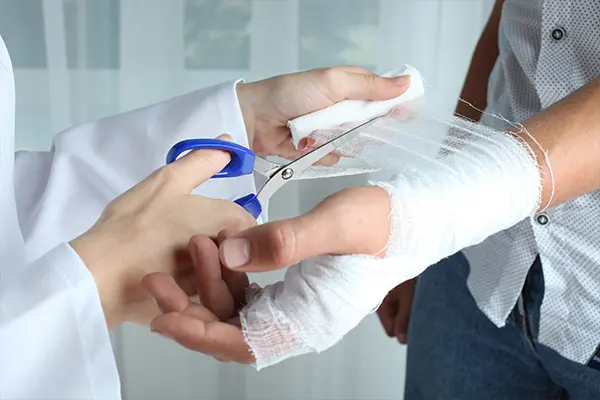
Zinc Paste Bandage - Effects, Application & Indication
Zinc paste bandages are semi-rigid compression bandages. If a part of the body is injured, swollen, or needs to be protected preventively, bandages of this type are tightly wrapped around the skin. As the name suggests, this is an elastic gauze bandage soaked in a mixture of zinc oxide, water, and a binding agent.
The application of zinc is a proven method in orthopedics, angiology, and sports medicine to ensure stabilizing wound regeneration. But what effect does the zinc paste bandage have when applied to the skin? In this blog post, we will clarify this as well as the areas of application and types of this reliable healing bandage!
Contents
Contents
What are zinc paste bandages and what effects do they have?
A zinc paste bandage is a practical compression bandage applied to a body region, such as the hand or foot, for specific indications. This is a conservative treatment method aimed at immobilizing the injured body part. The elastic bandage is soaked in a paste containing zinc oxide, water, and a binder, often gelatin. This special combination allows for flexibility when applying the bandage and the subsequent hardening of the material. When properly applied by a doctor, it can have the following effects on the patient:
- Compression force: Once hardened, the bandage exerts pressure on the tissue, reducing swelling.
- Cooling: The wet bandages cool the skin during application and are often perceived as pleasant by patients. Zinc paste bandages support the decongestant effect additionally.
- Stabilization: The hardened zinc paste bandages provide stabilizing support to the affected area.
- Anti-inflammatory: The zinc in the paste particularly reduces inflammation and swelling in the affected area.
- Pain relief: The compression and supportive assistance can minimize pain in the extremities.
- Healing promotion: By immobilizing the body part, the hardened bandage contributes to regeneration. Additionally, cell renewal can be supported in certain injuries.
- Skin protection: The skin-friendly protective bandage shields the sensitive area from external influences such as bacteria, friction, and impacts.
- Absorbent: Excess fluids are absorbed by the bandage material, ensuring a dry wound treatment after hardening.
Indications for the bandaging methods
If there is a mild to moderate sprain, swelling, or if these are to be prevented, the zinc paste bandage is used for all these conditions as directed by a doctor. Below are various application cases summarized:
- Stabilization of joints, such as in the case of sprains or epicondylitis
- Sports injuries of ligaments, tendons, or tissue
- Compression therapy, for example, for lower leg edema
- Tendon sheath inflammation
- Atopic dermatitis
The zinc paste bandage and its effects are unsuitable, however, for the initial treatment of knee injuries or in cases of tears or fractures.
Types of zinc paste bandages and their effects
Depending on the purpose and application area, two types of compression bandages can be distinguished in terms of flexibility: rigid zinc paste bandages and elastic zinc paste bandages.
Distinguishing features
Rigid zinc paste bandages
Elastic zinc paste bandages
Application area
Rigid zinc paste bandages
Injuries to the wrist, fingers, ankle, or foot
Elastic zinc paste bandages
Wounds on the knee, elbow
Purpose of application
Rigid zinc paste bandages
Immobilization, restriction of movement
Elastic zinc paste bandages
Support, but allow movement
Wearing time
Rigid zinc paste bandages
short
Elastic zinc paste bandages
longer-term
In our online shop, we offer you the possibility to quickly and easily order various zinc paste bandages – whether extra moist or particularly stretchable. Buy zinc paste bandages now at Medicalcorner24 for optimal effect!
Applying a Zinc Paste Bandage Correctly

Before wrapping the bandage material, ensure that the area to be treated is properly disinfected and all impurities are removed. The zinc paste bandage should only be applied with medical gloves, as the wet gauze bandage can leave stains and the substances in the paste can also cause allergic reactions.
In some cases, it is advisable to apply an additional underlay bandage before use. This can protect sensitive skin, counteract allergic reactions, or make removing zinc paste bandages from hairy skin more comfortable. The intermediate layer is often a tubular bandage or a gauze bandage. The advantage of performing the treatment without an intermediate layer is enhanced cooling and reduced tendency of the bandage to slip.

Once this decision is made, the bandage can be carefully wrapped in multiple layers around the treatment area. To make this as comfortable as possible for the patient, a brief warming of the material can help. The bandage should only be snug enough that circulation is not impaired and the skin can still breathe. At sensitive areas, such as the ankle, padding can also relieve pressure. To additionally secure the bandage, a cohesive fixation bandage can be applied, or a tubular bandage can be used as an overlay.
For optimal effect, the zinc paste bandage should be regularly checked and replaced if necessary during the wearing period. Once immobilization is complete, the bandage can be removed without replacement.
FAQ – Frequently Asked Questions
The wearing time varies depending on the severity of the injury, the indication, and the condition of the patient. Often, this treatment lasts for a period of several days to a week. However, you should seek your doctor's opinion to ensure your healing process is unhindered.
The bandage should be replaced every 2 to 3 days, but at the latest after five days, as per medical advice. As the swelling subsides, the bandage may become looser over time.
Applying a zinc paste bandage is a complex process that should only be carried out by medical professionals. This ensures the compressive effect and prevents injuries caused by incorrect application.
The shelf life varies depending on the consistency. Refer to the expiration date on the packaging insert.
The treating physician ensures that the bandage is applied snugly to the body and without wrinkles to provide stable support for the injured person. If during the wearing period there are feelings of numbness, circulation problems, or persistent tingling, the bandage must be immediately replaced.
You should generally protect your zinc paste bandage from moisture, as it will need to be replaced if it gets wet. During showering, you can cover the bandage with a bag and clean the area around it with a washcloth instead.



